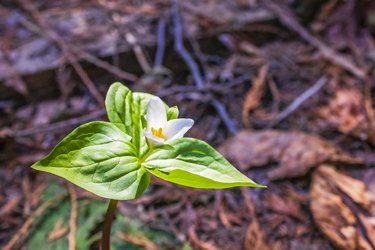
As you wander through a local park or along a hiking trail, keep an eye out for trillium. This genus of flowering plants has dozens of species, and it's common to spot trillium growing wild in many parts of eastern North America. Trillium belongs to the lily family and can grow in a variety of colors, including red, pink and yellow, but white trillium is perhaps the most common.
What Trillium Means
Video of the Day
Trillium's name is derived from the prefix "tri-," meaning "three" in both Latin and ancient Greek. It's easy to see why the plant was named for this number. Each trillium flower has three leaves, three petals and three sepals (the part of the flower that protects and encases the bud before it blooms).
Video of the Day
Trillium is also sometimes called the "wake robin flower" because it appears early in the spring like a robin. It's also sometimes called "birthroot" or "birthwort" because of its historical use as a medicinal aid during childbirth.
Trillium Flower Meaning
Many of the flowers that you'll find in a florist's shop have very specific symbolism. For example, daisies represent innocence, and roses generally represent love. Within the same flower family, different colors also mean specific things; that's why people generally choose red roses for their romantic partner and yellow roses for friends.
Trillium doesn't have that kind of symbolic messaging attached to it. Some people might see it as symbolic of the Holy Trinity because of its connection to the number three. Trillium isn't the kind of plant that people typically give as a gift since it doesn't do well in containers and really needs to be planted in soil.
Trillium does have special significance in certain parts of the world. It's the official wildflower of Ohio, as the flower grows in all 88 of the state's counties. It's also the official flower of Ontario and the official symbol of the government of Ontario. After World War I, there was a push in Canada to choose a single kind of flower that represented the country and could be planted on the gravestones of Canadian servicemen who died overseas. While no flower was ever officially chosen for that purpose, Ontario adopted trillium symbolism for its province.
How Trillium Is Used
Trillium has been used for medicinal purposes for centuries. Native Americans used the roots of red trillium to make tea that would help induce labor and aid in childbirth, and many midwives have followed the same practice to help their laboring clients. Historically, trillium was also used to make poultices, which are topical treatments for inflammation and conditions such as ulcers.
Caring for Trillium
While trillium often grows wild, you may also plant trillium from seeds or buy propagated trillium plants at a local nursery. These plants do well in hardy zones and in areas with lots of shade and damp, well-drained soil. Because it's a wildflower, it doesn't need a lot of special hands-on care to flourish; it just needs to be planted under the right conditions.
What's difficult about growing your own trillium is that this flower is slow to get going. It can take several years after planting seeds for them to germinate and bloom. Once established, they're tough, and one plant can survive for decades. Trillium doesn't regrow easily, so this is one plant that you should enjoy in nature and not display in a vase in your kitchen. Cutting the bloom may damage the plant, and a new flower won't grow in that area. Take plenty of photos of your local trillium and then leave them alone.